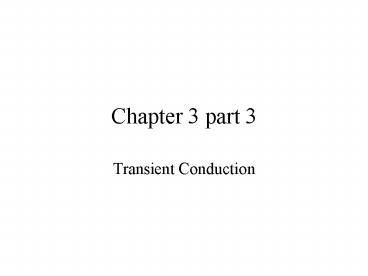Chapter 3 part 3 - PowerPoint PPT Presentation
1 / 18
Title:
Chapter 3 part 3
Description:
Chapter 3 part 3 Transient Conduction Introduction Introduction Bi 0.1 Bi 0.1 Chapter 3 part 3 Transient Conduction Introduction Introduction Bi – PowerPoint PPT presentation
Number of Views:80
Avg rating:3.0/5.0
Title: Chapter 3 part 3
1
Chapter 3 part 3
- Transient Conduction
2
Introduction
System to be studied Object at an initial
uniform and constant temperature T0 is introduced
in a fluid at a temperature . The volume of
fluid is such that is unaffected.
Fluid
3
Introduction
- Heat transfer is time dependent
- Biot Number (Bi) is an important characteristic
of such heat transfer mechanisms - L is the characteristic length(thickness of wall,
volume/area of object, etc) - 3 conditions
- Bi ltlt 0.1
- Bi gtgt 0.1
- Bi 0.1
4
Bi ltlt 0.1
Implies that k is large, L is small and or h is
small. Therefore, the thermal resistance in solid
is small compare to the convective resistance in
the fluid. Results Very little heat gradient in
solid Assume temperature in solid is only
function of t
5
Energy balance Energy in Energy out Energy
generated accumulation - Energy out
accumulation Energy out Accumulation
Initial condition Solution
6
Reformat exponent
Biot number
Fourier number
Thermal diffusivity
7
Bi gtgt 0.1
Implies that k is small, L is large and or h is
large. Therefore, the thermal resistance in solid
is large compare to the convective resistance in
the fluid. (Negligible Surface
Resistance) Results Heat gradient in
solid Assume temperature at surface of solid
equal to temperature of fluid a t gt 0
8
For a plane wall
x
h
h
Cold air
Cold air
L
Energy balance on element of volume Energy in
Energy out Energy generated accumulation
9
Energy balance Energy in Energy out Energy
generated accumulation Energy in - Energy out
accumulation Energy in Energy out
Accumulation
10
Boundaries conditions T To at t 0 for 0
lt x lt LT T? at x 0 for t gt 0T T? at x
L for t gt 0 solution
11
For the heat transfer rate we get Graphical
solution
12
Bi 0.1
Most general case of transient heat transfer We
have significant internal and surface resistance
x
For a plane wall
h
h
Cold air
Cold air
L
13
Solution
Table 5.1
if Fogt0.2, first term of summation is sufficient
14
For an infinite cylinder
are the positive roots of the transcendental
equation
J0 and J1 are Bessel functions of the first kind
15
For a sphere
are the positive roots of the transcendental
equation
16
Semi Infinite Wall Surface conditions and
Surface conditions
17
Semi Infinite Wall Surface conditions
18
Multidimensional effects
L
L
L
L
R
R































